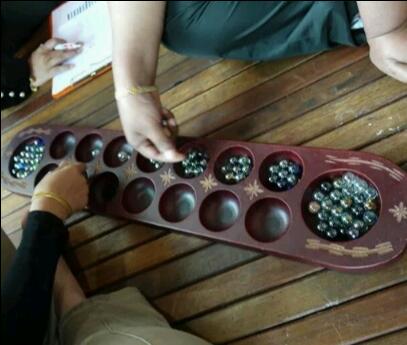
Category : Blogs
Sub Category : Sports
Congkak is a mancala game of ancient Javanese origin played in Indonesia, Singapore, Malaysia, Brunei and Southern Thailand. It has simple rules that allow the boards to have different numbers of holes. Congkak boards are often made of teak or mahogany wood which are often elaborately carved into various shapes such as dragon, boat or bird.
The word congkak is believed to originate from an old Malay word "congak", meaning "mental calculation", which is mainly practiced in this game. It is regarded that an efficient player who mentally calculates a few steps in advance will have an advantage in collecting points to win the game.
A brief history: Mancala is one of the oldest known games to still be widely played today. Mancala is a generic game for a two-player turn-based strategy board game played with small stones, beans, seeds or marbles placed in rows of holes on the board. (Today marbles are favoured for easy handling). The objective is to capture all or most of the opponent's marbles. Versions of the game date back to the 7th century, and evidence suggests the game first existed in ancient Egypt. The oldest mancala game boards were found in a ruined fort of Roman Egypt and date back to the 4th century AD. The game was likely introduced to Southeast Asia by Indian merchants in the 15th century. It is believed to have spread throughout the Indonesian Archipelago through the merchants via Malacca (south of Peninsula Malaysia), which was an important trading post at that time. Initially, it was a game reserved solely for the King, his family and palace residents, however, it later spread to the general population of the kingdom.
The typical congkak board has fourteen holes - seven on each side of the board, plus an additional bigger hole for each player on each ends of the board. Each player controls the seven holes (known as 'house') on their side of the board, and their score is the number of marbles accumulated in the big hole, which is known as 'storehouse'. A total of 98 marbles are used to play the game. To start off the game, seven marbles are placed in each 'house' except for the players 'storehouse'. The objective of the game is to capture more marbles in the storehouse than one's opponent.
The method of play is actually very simple. Both players begin simultaneously by scooping up all the marbles in any house on their side of the board and each drops a marble into the next house and continues clockwise depositing one marble into every house thereafter. A player drops a marble into his storehouse each time he passes it but does not deposit any into his opponent's storehouse. How the game continues, depends on where the last marble of each scoop is deposited.
If the last marble from a scoop drops into the player's own storehouse, he then continues his move by scooping up marbles from any of his houses and distributes them in the houses round the board but not in his opponent's storehouse. If the last marble from the scoop drops into a house on either side of the board containing marbles, the player continues his move by scooping up all the marbles in that house and continues distributing them as described above.
If the last marble from the scoop drops into the player's house which is without marbles, the player is entitled to collect all the marbles in his opponent's house that is directly opposite his own where he had dropped the last marble. These marbles collected from his opponent's house, together with his last marble dropped from the scoop are deposited in his own storehouse. If the opponent's 'house' opposite his own is empty, he deposits only that last marble into his storehouse, making him lose his turn to play. It is then the opponent's turn to distribute his marbles round the board. If the last marble drops into an empty house belonging to the opponent, the player loses his turn to play and he also forfeits his marble and leaves it in the opponent's house. The first round ends when a player has no more marbles left in any of his house. The remaining marbles are awarded to his opponent.
Play resumes in the second round with players redistributing the marbles from their own storehouse to their own houses. Beginning from the right to left, seven marbles are placed in each house. If a player does not have sufficient marbles to fill all of his own houses, the remaining houses are left empty and are considered 'burnt' and out of the play of the game. The leftover marbles are deposited into his own storehouse and the opponent deposits the excess marbles he had won from the first round into his own storehouse.
The loser of the first round gets to start the second round. Play is continued as before but players will bypass 'burnt houses', meaning no marbles will be dropped into these houses. If a marble is accidentally dropped into a 'burnt house', it is confiscated and stored in the opponent's storehouse. Play continues until one player loses all his houses or concedes defeat.
Reading it in writing may make it sound very confusing but it is actually one of the most fun and interactive game to play. Here in Malaysia, you can find congkak as one of the activities available in most hotels and resorts. It is a game that can be played at any time, anywhere you can find a congkak board. I personally like to play it on rainy days when I'm holed up in the house with nowhere to go. I'll make a pot of coffee, pile on some snacks and I'm good to go for hours playing this old traditional game. This game has also been turned into an indoor sport and Kuala Lumpur has hosted quite a number of congkak tournaments over the years.





